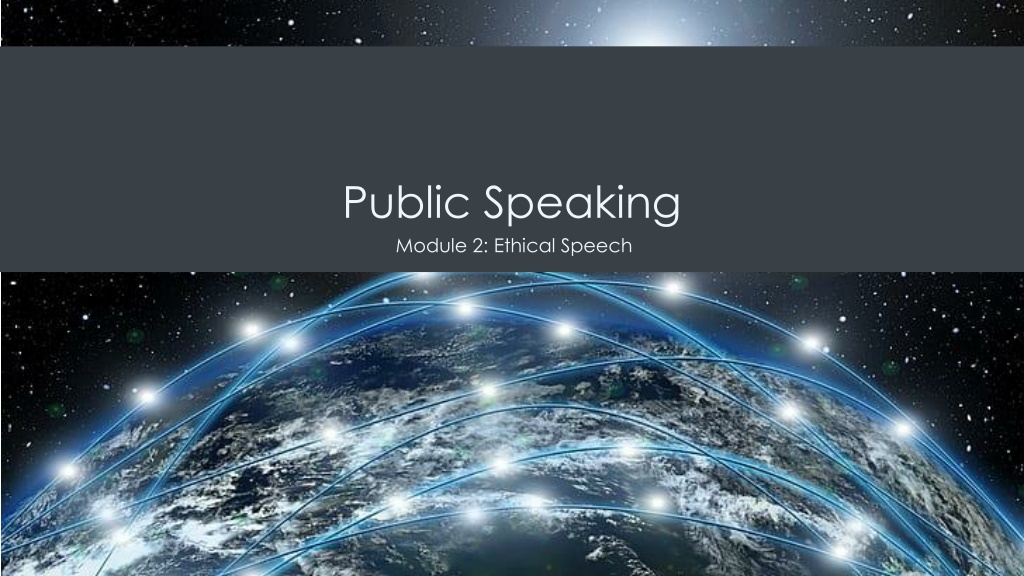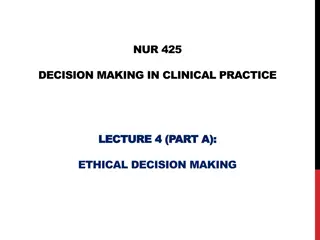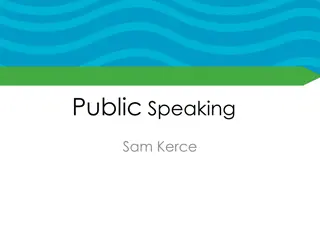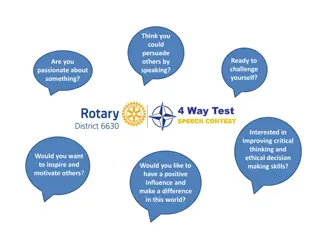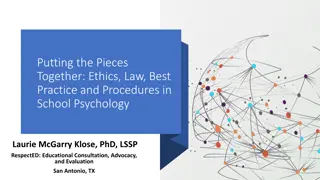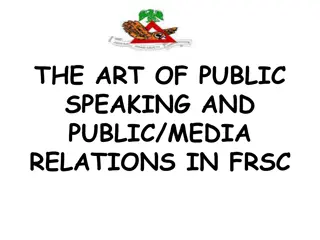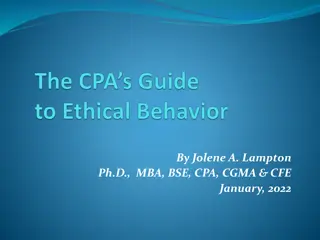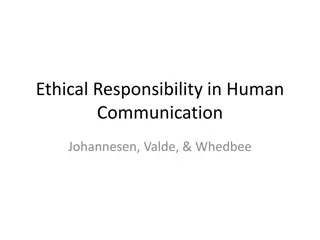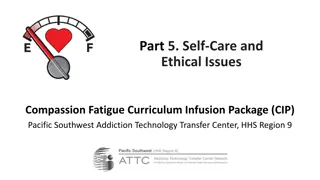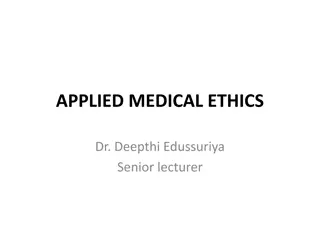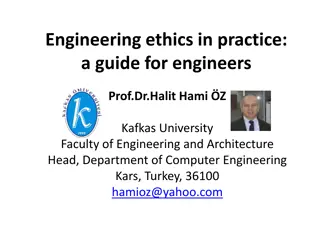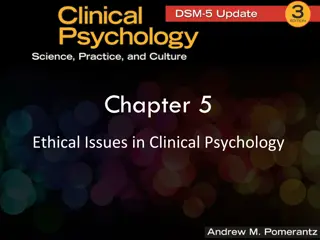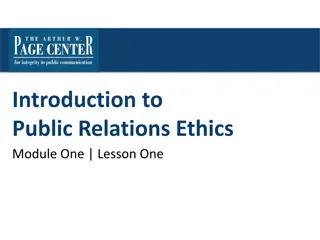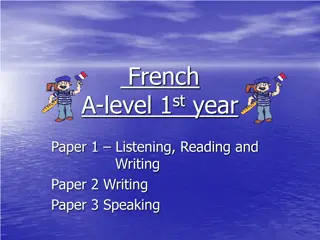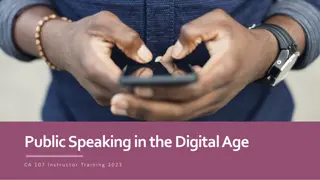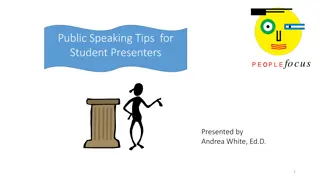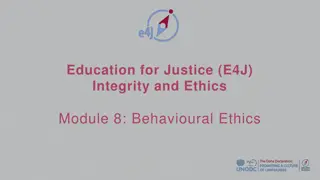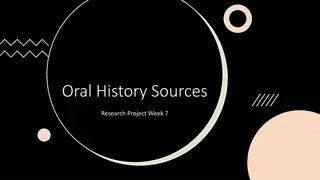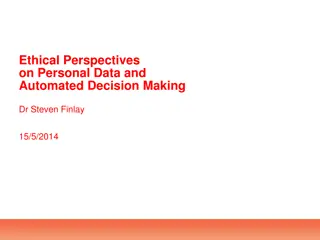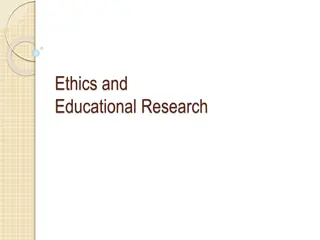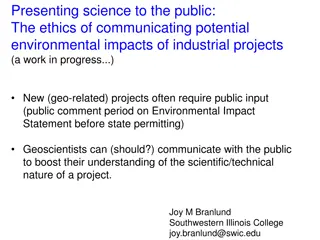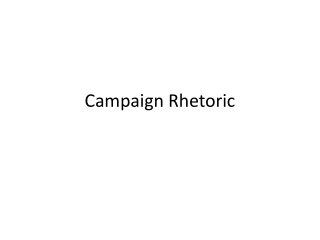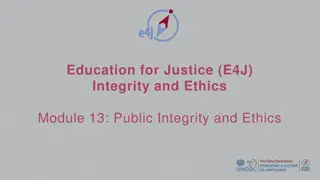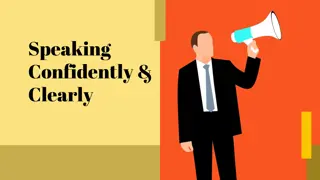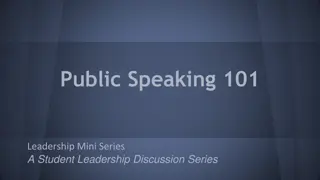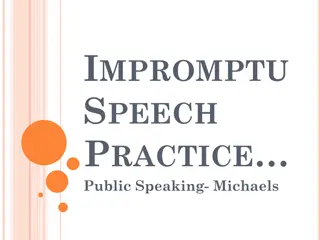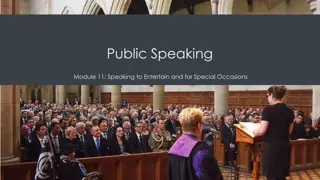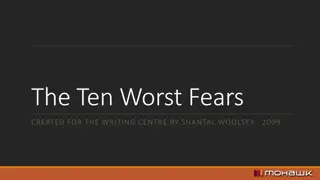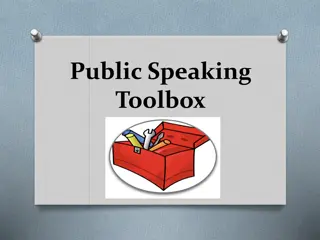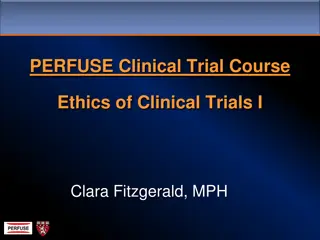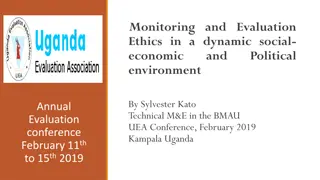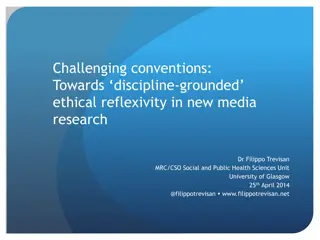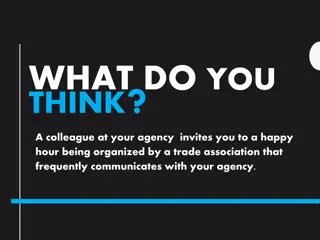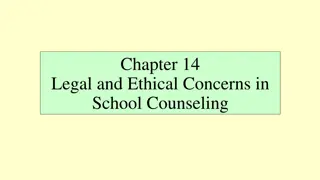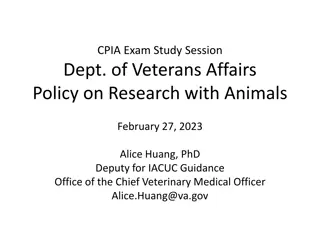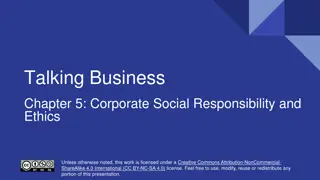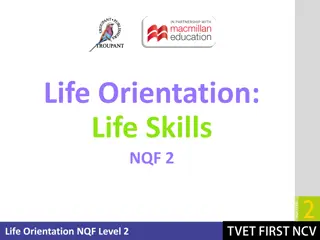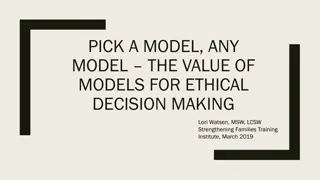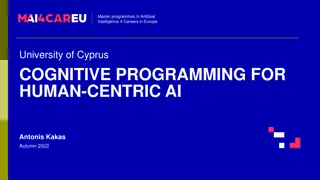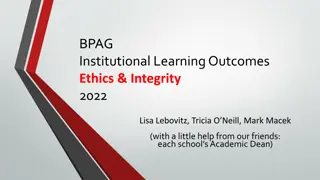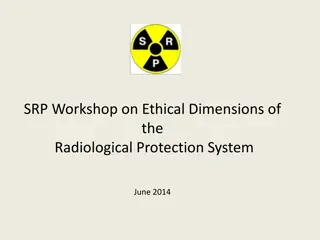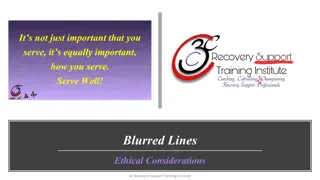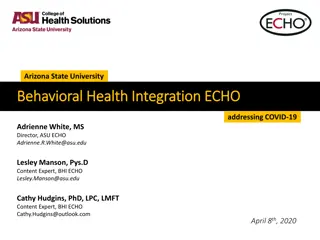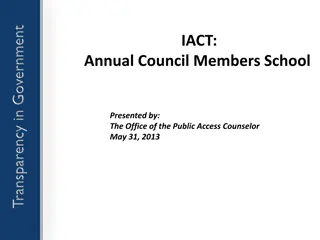Exploring Ethical Considerations in Public Speaking
Explore the importance of ethics, morals, and legality in public speaking, understanding the distinctions between them, and how they impact individuals like lawyers, doctors, judges, and teachers. Delve into the significance of maintaining credibility, presenting fair arguments, being honest, and following shared moral values to uphold integrity in public speaking.
Download Presentation

Please find below an Image/Link to download the presentation.
The content on the website is provided AS IS for your information and personal use only. It may not be sold, licensed, or shared on other websites without obtaining consent from the author. Download presentation by click this link. If you encounter any issues during the download, it is possible that the publisher has removed the file from their server.
E N D
Presentation Transcript
Public Speaking Module 2: Ethical Speech
Module Learning Outcomes Demonstrate an understanding of ethical considerations in public speech 2.1: Explain the importance of ethics in public speaking 2.2: Identify key principles of ethical communication 2.3: Identify how to quote and paraphrase sources and avoid plagiarism
Learning Outcomes: Ethics, Morals, and Legality 2.1: Explain the importance of ethical considerations in public speech 2.1.1: Define ethics 2.1.2: Differentiate between morality, legality, and ethics 2.1.3: Explain why ethics are so important in public speaking
Morals, Ethics, and Legality LEGALITY MORALS ETHICS Personal values with respect to right and wrong Based on law Set of standards or rules governing a person s conduct Established penalties for behavior that breaks the law A means to be and do good Rules one abides by in order to remain within a community or profession Personal compass Explicit statutes, regulations, and codes that govern Unwritten code of behavior Written Code of Ethics Interpreted by courts Distinguished by a certain community or social setting While guided by ethics and morality, the law is separate INDIVIDUAL GOVERNMENT PROFESSIONAL / ORGANIZATIONAL Always tell the truth Hippocratic Oath Workplace Discrimination Laws
Class Discussion: Consider how the different layers of morals, ethics, and legality are present in one of the following examples: A Lawyer A Doctor A Judge A Teacher Discuss how an action taken by that individual may be viewed as acceptable or unacceptable through each lens Moral Ethical Legal Discuss the impacts of that action to the individual through each lens Moral Ethical Legal
Ethics in Public Speaking To maintain your credibility and reputation To present a fair and accurate argument of your thesis To provide honest facts with integrity and without deception or distortion To abide by shared or common moral values and beliefs
NCA Credo for Ethical Communication We advocate truthfulness, accuracy, honesty, and reason as essential to the integrity of communication. We condemn communication that degrades individuals and humanity through distortion, intimidation, coercion, and violence, and through the expression of intolerance and hatred. We endorse freedom of expression, diversity of perspective, and tolerance of dissent to achieve the informed and responsible decision making fundamental to a civil society. We are committed to the courageous expression of personal convictions in pursuit of fairness and justice. We strive to understand and respect other communicators before evaluating and responding to their messages. We advocate sharing information, opinions, and feelings when facing significant choices while also respecting privacy and confidentiality. We promote access to communication resources and opportunities as necessary to fulfill human potential and contribute to the well- being of individuals, families, communities, and society. We accept responsibility for the short- and long-term consequences for our own communication and expect the same of others. We promote communication climates of caring and mutual understanding that respect the unique needs and characteristics of individual communicators. https://www.natcom.org/sites/default/files/Public_Statement_Credo_for_Ethical_Communication_2017.pdf
Practice Question 1 A set of standards or rules governing a person s conduct best describes: A. Morals B. Ethics C. Legality D. Religion
Learning Outcomes: Principles of Ethics in Communication 2.2: Identify key principles of ethical communication 2.2.1: Define bias X.2.2: Define conflict of interest 2.2.3: Explain the principles of inclusive, responsible speech 2.2.4: Identify the importance of using inclusive language 2.2.5: Identify the importance of avoiding hate speech 2.2.6: Reflect on the scope of free speech in the context of public speaking
Freedom of Speech Congress shall make no law respecting an establishment of religion, or prohibiting the free exercise thereof; or abridging the freedom of speech, or of the press; or the right of the people peaceably to assemble, and to petition the Government for a redress of grievances. Exceptions: 1. Speech directed to inciting or producing imminent lawless action and is likely to incite or produce such action 2. Speech that threatens the U.S. president
Hate Speech An ethical violation of speech with clear and severe consequences Categorized as speech that attacks or incites violence against individuals or groups based on characteristics protected by the U.S. Federal Anti-Discrimination Law race religion national origin age (40 and over) sex sexual orientation and gender identity pregnancy familial status disability status veteran status Speech against un-protected characteristics is NOT considered hate speech
Bias and Conflict of Interest CONFLICT OF INTEREST BIAS IMPLICIT BIAS Ethical challenge when an individual or organization is involved in multiple interests that are at odds with one another A tendency toward or against someone or something based on preferences and predispositions Unconscious stereotypes that lead to bias DANGERS DANGERS Prevent you from making a fair or reasoned choice about something: Healthcare Law Enforcement Education Human Resources Public Communication Compromised integrity Loss of Trust How to resolve COI Tools to Recognize and Correct Implicit Bias FLEX Model | Implicit Association Test Recuse yourself | Make COI transparent
Inclusive Language and Responsible Speech The terms we use to represent individuals and groups How we frame statements of general or universal identity DO DON T Use language about identity in unequal ways by avoiding: Stereotypes Prejudice Fairly represent all listeners: Inclusive Pronouns People-First Language Frame some groups as the unspoken standard or default by using: Gender-specific terms Sexist language Racist language Follow principles of Race Reporting Guide Pay attention to how people and groups self-identity Use Denigrating language Show awareness of intersectionality Avoid discussing race, gender, religion, or disabilities
Practice Question 2 If you are in a situation where your personal interests compete with your professional interests, what step can you take to remain ethical and/or responsible? A. Make your conflict of interest transparent B. Take the Implicit Association Test C. Follow the FLEX model D. Keep your thoughts private
Practice Question 3 Expressions of hostility toward certain professions of affiliation groups is considered: A. Hate Speech B. Unethical speech C. Inclusive Language D. Illegal Speech
Class Discussion Freedom of Speech does not mean freedom from consequence What are some examples of : Illegal Speech Unethical Speech Irresponsible Speech What are the potential consequences to the speaker and the audience when each of the above is used?
Learning Outcomes: Ethically Using Sources 3.2: Identify how to quote and paraphrase sources and avoid plagiarism 3.2.1: Identify types of plagiarism and understand how to avoid them 3.2.2: Explain how to cite sources in written and oral speech materials 3.2.3: Explain how to paraphrase and summarize effectively in public speaking
Plagiarism 1. Presenting someone else s work as your own DEFINITION: 2. Not giving credit for someone else s ideas, words, images, video, or other contributions UNINTENTIONAL INTENTIONAL Fabrication: Fabricating a source and quotes Using the same paper for two different classes Mosaic plagiarism: changing a few words from the original source and not citing it Quoting a source incorrectly Failing to properly introduce an idea you ve drawn from someone else Using a pre-written paper or parts of a pre-written work Omitting oral attributions from a speech
Oral Source Attribution SOURCE TYPE INFORMATION TO CITE Periodical name Date Organization, Agency, Institution, or Corporation that owns the website Date of posting or last update Name and credential of interviewee Date of interview BEST PRACTICES Periodicals Provide credentials of individuals and/or sources Website Introduce source with a signal phrase Personal Interview Use previously cited when using a repeat source Publication name Date Name and credential of interviewee Title Author Name of broadcast Date of broadcast Network name Cite at the beginning of the idea or quotation Published Interview Book Media Broadcast
Written vs Oral Citations Proper Written Source Citation Proper Oral Attribution Your time is limited, so don t waste it living someone else s life (Jobs, 2005). In his 2005 commencement address at Stanford University Steve Jobs said, Your time is limited, so don t waste it living someone else s life. Eat food. Not too much. Mostly plants (Pollan, 2009, p.1). Michael Pollan offers three basics guidelines for healthy eating in his book, In Defense of Food. He advises readers to Eat food. Not too much. Mostly plants. The Assad regime s escalating violence in Syria is an affront to the international community, a threat to regional security, and a grave violation of human rights. . . . [T]his group should take concrete action along three lines: provide emergency humanitarian relief, ratchet up pressure on the regime, and prepare for a democratic transition (Clinton, 2012). In her February 24 speech to the Friends of Syria People meeting, U.S. Secretary of State Hillary Clinton warned that Assad was increasing violence against the Syrian people and violating human rights. She called for international action to help the Syrian people through humanitarian assistance, political pressure, and support for a future democratic government. In his 2009 Back to School speech, President Obama encouraged students to participate in school activities like student government and debate in order to try out the skills necessary for a leadership position in the government. Maybe you could be a mayor or a Senator or a Supreme Court Justice, but you might not know that until you join student government or the debate team (Obama, 2009).
How to use Sources QUOTE PARAPHRASE SUMMARIZE Written citation uses quotation marks Tells the main idea of a piece of writing Phrase ideas from another person s text in your own words Oral delivery will indicate through language: quipped , stated , etc. Wider scope than a paraphrase Used for one statement, not more than a few lines Shortened version of a paragraph, chapter, article, etc. Useful for telling basic facts: dates, statistics, places, etc. Only use when simple, short, memorable, or exact wording is important Do not paraphrase out of context Highlight or relate the main facts of the reference Use sparingly Do not add information, comments, or analysis to the paraphrase Do not quote out of context Only major facts are given Do not use air quotes to deliver CONDENSE AND REWORD ONE IDEA IN YOUR OWN WORDS SHORT, EXACT WORDING
Practice Question 4 When information from a source is reworded and condensed to include only the main idea, how is that source being used? A. Quote B. Paraphrase C. Summary D. Citation
Practice Question 5 Using the source information from the example below, which is the correct oral source attribution? Publication: Article Title: Author: Date: New York Times The B.C.S. Will Live, but Faces Tinkering Joe Drape Tuesday, December 9, 2003 A. New York Times of December 9, 2003 B. Joe Drape of the New York Times on December 9, 2003 C. Joe Drape, in his article, The B.C.S. Will Live, but Faces Tinkering, published in the New York Times on December 9, 2003 D. The B.C.S. Will Live, but Faces Tinkering by Joe Drape
Quick Review Morals, Ethics, and Legality all serve to guide our conduct Morals are unwritten codes of behavior based on individual values Ethics are organizational or professional sets of standards or rules that reflect the values of that organization/profession Legality, based on law, is explicit statutes, regulations, and codes that govern Public Communication must uphold ethical and legal standards Freedom of speech has legal limits when inciting lawlessness or threatening the president Hate speech is ethically prohibited and has consequences While varied in definition, it is considered speech against legally protected groups Ethical Speech uses inclusive language and includes recognizing and taking steps to avoid : Bias and Implicit Bias Conflict of Interest Ethical public speaking requires properly attributing ideas, words, images, video, or other contributions through both written and verbal means
